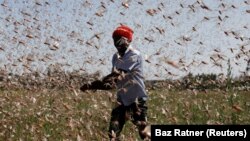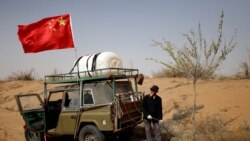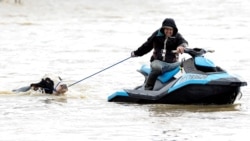Extreme weather events in 2021 have broken records around the world. Hundreds died in storms and heatwaves. Farmers struggled with drought, and for some, extreme cases of insects. Wildfires set new records for carbon output. Fires destroyed forests, towns, and homes.
Many of these events were worsened by climate change. Scientists say there are more to come, and worse, as the Earth’s atmosphere continues to warm through the next ten years and beyond.
Here are some of the events over the last year:
February:
Kenya and other parts of East Africa battled some of the worst locust plagues in tens of years. A locust is a kind of insect that eats crops. The insects destroyed crops and grasslands meant for animals. Scientists say that unusual weather worsened by climate change created good conditions for the insects to expand.
March:
Beijing’s sky turned orange and flights were grounded during the Chinese capital’s worst sandstorm in ten years.
Busloads of volunteers arrive in the desert each year to plant trees, which can help the soil and reduce the effects of wind. Scientists predict climate change will worsen the growth of deserts, or desertification, as hotter summers and drier winters reduce moisture levels.
June:
Hundreds died during a record-breaking heatwave in the United States and the Canadian Pacific Northwest, which scientists said would have been “virtually impossible” without climate change.
Over several days, power lines melted and roads became mis-shapen. Cities struggled to deal with the heat. They opened cooling centers to protect the locals. During the heat wave, Portland, Oregon, hit an all-time record high of 46.7 Celsius.
July:
Large parts of South America suffered from a prolonged drought. Chile is dealing with a ten-year-long megadrought linked to climate change. This year, Brazil saw one of its driest years in a century.
In Argentina, the Parana, South America’s second-longest river, fell to its lowest level since 1944.
Around the world, heatwaves are happening more often and are becoming more severe.
August:
Nearly all the world’s mountain glaciers are shrinking due to climate change. In the Alps, Swiss hotel workers placed protective cloth over one of Mount Titlis’s glaciers during the summer months to keep what ice is left.
Switzerland has already lost 500 of its glaciers. The government said it could lose 90 percent of the 1,500 that remain by the end of the century if world carbon output continues to rise.
September:
Structures and homes in Russia are increasingly in danger as underground permafrost melts and damages the land under them.
Permafrost was once a good building base, in some areas staying frozen as far back as the last Ice Age. Rising world temperatures threaten the permafrost’s ice, soil, rocks, sand, and organic matter.
November:
A large storm emptied a month’s worth of rain over two days in British Columbia in Canada. It created floods and moving soil that destroyed roads, railroads, and bridges. It is likely the most expensive natural disaster in Canada’s history, although officials are still examining the damage.
Meteorologists, or scientists who study the weather, said the rain had come from an atmospheric river. It is a flow of gaseous water stretching hundreds of kilometers long from near the equator, the tropics. Scientists say atmospheric rivers are expected to become larger, and possibly more destructive, with climate change.
I’m Gregory Stachel.
Lisa Shumaker and Andrea Januta reported this story for Reuters. Gregory Stachel adapted it for VOA Learning English. Susan Shand was the editor.
____________________________________________________________________
Words in This Story
drought – n. a long period of time during which there is very little or no rain
plague – n. a large number of harmful or annoying things
moisture – n. a small amount of a liquid (such as water) that makes something wet or moist
virtually – adv. very nearly: almost entirely
glacier – n. a very large area of ice that moves slowly down a slope or valley or over a wide area of land
permafrost – n. a layer of soil that is always frozen in very cold regions of the world










